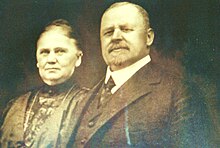J. Hakenmüller's tomb
The grave of J. Hakenmüller is located in the Markenhalde cemetery in the Tailfingen district of Albstadt in the Zollernalb district in Baden-Württemberg . The tomb was made in 1921 by the Stuttgart stone sculptor Kurt Fanghänel (* 1865 or 1866; † March 8, 1930) and is a listed building .
The widow of the textile manufacturer Johannes Hakenmüller , who died in 1917 , was Luise Hakenmüller, b. Krauss, as well as the four sons Julius, Paul, Alfred, Karl and the daughter Luise jun. acquired an approximately 50 m² grave field from the local administration of Tailfingen at the Markenhalde cemetery and commissioned the tomb from Fanghänel. The previously occupied grave field of this family, who first emigrated from Nördlingen to Ebingen around 1600 and then moved to Tailfingen, was located in the abandoned old cemetery along today's Friedhofstrasse.
Fang Hänel set up a sculpture in the center in front of the grave wall, which is an original-sized copy of the famous figure of the risen Jesus - often also called the blessing Christ - by the Danish sculptor Bertel Thorvaldsen (1770–1844), made of Carrara marble had made for the Copenhagen Cathedral and was later frequently copied. The Prussian King Friedrich Wilhelm IV also acquired such a copy, which stood in the inner courtyard of the Friedenskirche in Potsdam , which he built until 1854 .
When modeling the figure in his studio, Thorvaldsen forgot to support the arms that were originally raised under the protective cloak overnight, which is why they had leaned slightly downwards until the next morning. The artist saw in this a sign that Christ had turned even more clearly to the dead in the grave and their resurrection.
In the USA, this version is considered the most perfect statue of Christ in the world, at least since the Church of Jesus Christ of Latter-day Saints , a Mormon denomination group in the state of Utah , used it as its trademark at the beginning of the 20th century.
Kurt Fanghänel, however, took up the connection between the risen Christ and his other biblical title, David's Son , by placing a Star of David over the figure on the back wall . However, the two side arms on the edges of the rear wall on the left and right are kept in the so-called plait style, which was in fashion at the time of the Empire style .
For the inscription of the meanwhile weathered left and right tablets of their grave, the Hakenmüller family chose those verses from Isaiah 54:10, which the Protestant pastor Scheuerlen had taken as guiding principles for his sermon on May 2nd, 1917 at the funeral of Johannes Hakenmüller:
- Mountains should give way and hills should fall, but my grace should not leave you, and the covenant of peace should not fall, says the Lord, your builder. (left panel)
and from John 11:26:
- I am the resurrection and the life. Whoever believes in me will live whether he dies soon. And whoever lives there and believes in me will never die. (right panel)
Buried in front of it in the upper field from left to right are Carl and Lina Hakenmüller (as the last to be buried there), in the middle Johannes and Luise Hakenmüller, on the right Paul and Helene Hakenmüller. Jürgen Olaf Hakenmüller (1922–1950), a son of Helene and Paul Hakenmüller, rests in the now abandoned grave on the right.
The foremost grave on the left is the final resting place of Hakenmüller's grandson Hans-Martin Ammann, the youngest son and heir of the Tailfinger textile manufacturer Carl Ammann and his wife Luise Ammann, nee. Hakenmüller, the aforementioned daughter of Johannes and Luise Hakenmüller. In the second front grave from the left, Katharina Lorch called "Kätherle" was buried. She worked for Johannes and Luise Hakenmüller as a domestic servant for over 30 years, and later also for Julius Hakenmüller. Among them are the tombs of Lore, a sister of Hans-Martin Ammann, and of Carl and Luise Ammann, their parents.
After the last remaining child of Paul Hakenmüller, Rolfdieter Hakenmüller, moved with his family to Hechingen in 1953 , the family grave was later no longer fully occupied. Julius Hakenmüller († 1968) and Alfred Hakenmüller were also not buried here for family reasons.
In 1948 Julius Hakenmüller and his sister-in-law Helene commissioned the Stuttgart garden architect Hermann Aldinger to arrange the entire grave field. Terraces were laid out according to Aldinger's design . The grave area borders and the bench in the upper right corner were made by Alfred Burrer's stonemasons in Maulbronn from Gauinger travertine , a very weather-resistant freshwater limestone , from which the same workshop also made the seating and walls of the Berlin Olympic Stadium .
Individual evidence
- ↑ Stone sculptor Kurt Fanghänel according to various years of address book, life data according to Nekrolog in Chronik der Stadt Stuttgart, Volume 50 (1990) , cf. also Libellenbrunnen (Stuttgart) and Städtisches Lapidarium Stuttgart - a sculptor Carl Fanghaenel / Karl Fanghaenel cannot be proven for Stuttgart!
- ↑ List of monuments of the Zollernalb district ( page no longer available , search in web archives ) Info: The link was automatically marked as defective. Please check the link according to the instructions and then remove this notice. , accessed on August 28, 2017




